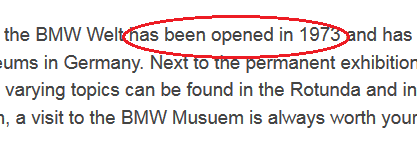While the quality of machine translation (MT) has improved significantly in recent years, advanced MT tools such as DEEPL still fail to arrive at effective solutions for a wide range of translation problems. Most frequently, MT runs aground when the development of a viable solution requires not only an awareness for the broader context of the discussion (viz. the “big picture”), but also judicious and creative editorial decision-making to resolve linguistic incompatibilities. The divergent usage practices that prevail in German and English when enumerating examples provide a vivid demonstration of this fact. Far from being rare or obscure, the problems that can emerge in this regard are exceedingly common and conspicuous. Nevertheless, they are also highly irregular and context-dependent, and have subtle gradations of severity. These attributes make it exceedingly difficult to describe and subsume this “problem nexus” under a unified and precise definition.
I previously touched upon this translation issue in a blog post I wrote back in 2009. However, that post merely cited an example of the problem, without seeking to define its contours or point to potential solutions, a deficit that I hope to remedy here. The nub of the problem is this: German prose has a tendency to introduce examples in a manner that seems excessively abrupt within the context of a direct translation. Most typically, the problem lies at the level of composition, or proper sentence flow: the faithful rendering of the elements of the German sentence leads to the formation of “example lists” or “enumerative subclauses” that strike the reader as highly disjointed, excessively stilted, or simply incompatible with acceptable usage.
Let us turn to a specific example:
Carbon uptake depends on e.g. local flora, the terrain type, climate zone, and land management practices.
Here, the sudden transition to examples using “e.g.” is very characteristic of German prose. While this English sentence could certainly be viable if the sentences that immediately preceded it cited the category to which the examples belong, either explicitly or implicitly, this information was completely absent in the original discussion. Usually, the best solution when confronting “abrupt examples” of this nature is to specifically state the overarching category from which the examples stem, even if this category is very general, as in the following revised sentence, which deploys “including” as a solution for a smoother segue.
Carbon uptake depends on various factors, including local flora, the terrain type, climate zone, and land management practices.
Let us look at another overly abrupt transition to examples in the absence of an explicit category.
Individuals can offset residual emissions through e.g. CDR projects.
Native speakers of English will agree without hesitation that this transition using “e.g.” is stilted. Based on the broader context (which I will omit here), the easiest solution to this real-world example was to introduce “voluntary contributions” as the broader category.
Individuals can offset residual emissions through voluntary contributions (e.g. to CDR projects).
Let us consider a third example, taken from the user manual for my Bosch dishwasher. I encountered the following sentence while reading about the “hygienePlus” feature.
This option is ideal for cleaning e.g. chopping boards and baby bottles.
The best strategy for turning the above sentence into reasonable English would be to transition by identifying the broader category in question.
This option is ideal for cleaning items that require a higher hygienic standard, such as chopping boards or baby bottles.
The above examples are mere isolated instances of a much broader problem that has a wide variety of manifestations. One reason why this problem is particularly tricky to identify and resolve is that transitions to examples when the category is left merely implied can work in many circumstances in English. Indeed, leaving the category unnamed is a particularly common approach when the stating the category is difficult, problematic, or unnecessary. In such circumstances, the English term “say” is commonly deployed as a connector, as in the following passage.
(James Surowiecki, “Taking on the Drug Profiteers,” The New Yorker, October 12, 2015).
In the passage, Germany is cited as just “one possible example” of the larger set of countries that have reliable drug approval systems, and which, by extension, should be able to import drugs to the US without the need for separate FDA approval. As stating this category explicitly would be problematic (that is, politically controversial), the author phrases the exposition to make the category relatively clear yet only implied. And it is precisely here that we find a source of divergence from German expositional strategies, for at least in some cases, it would appear that the German author does not necessarily feel the need to “pity the reader” and make the category to which examples belong sufficiently clear with supplemental context. It is the reader who, in the manner of a supplicant, pleading with the Privatdozent to partake in his greater knowledge, must do the extra work of deducing the nature of the category in question. In this way, I would tentatively hypothesize that the German use of “z. B.” can be reflective of underlying attitudes regarding the nature of communication and the respective (power) roles inhabited by the author and reader.
Interestingly, despite the prevalence of this all-too-common pitfall when moving from German to English, I have never seen it discussed at another language blog or website, and I often see professional translators fail to handle it adroitly when comparing texts at, say, a museum. The pervasive lack of recognition for the problem is most likely attributable to the fact that it resists clear and easy formalization and also has many subtle gradations of severity. Indeed, this “slippery” and “context-dependent” problem not only derails MT tools with great reliability, but German-speaking authors of English as well.









